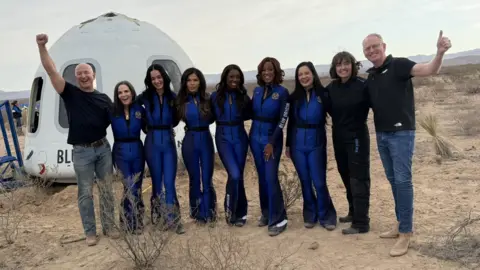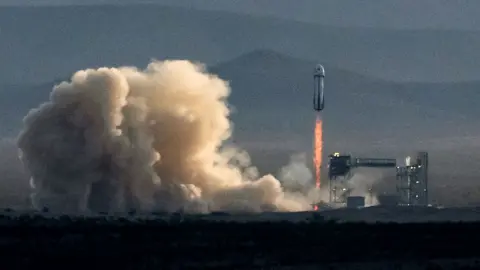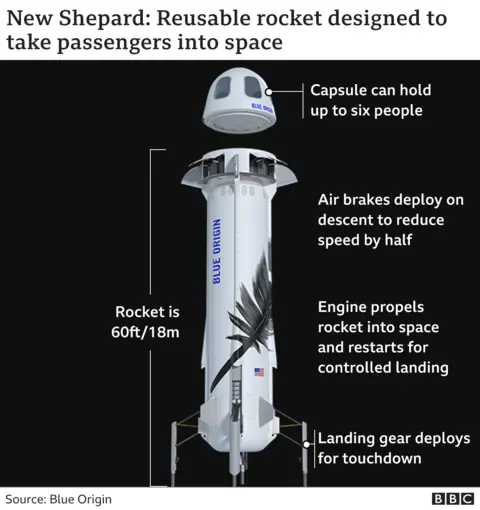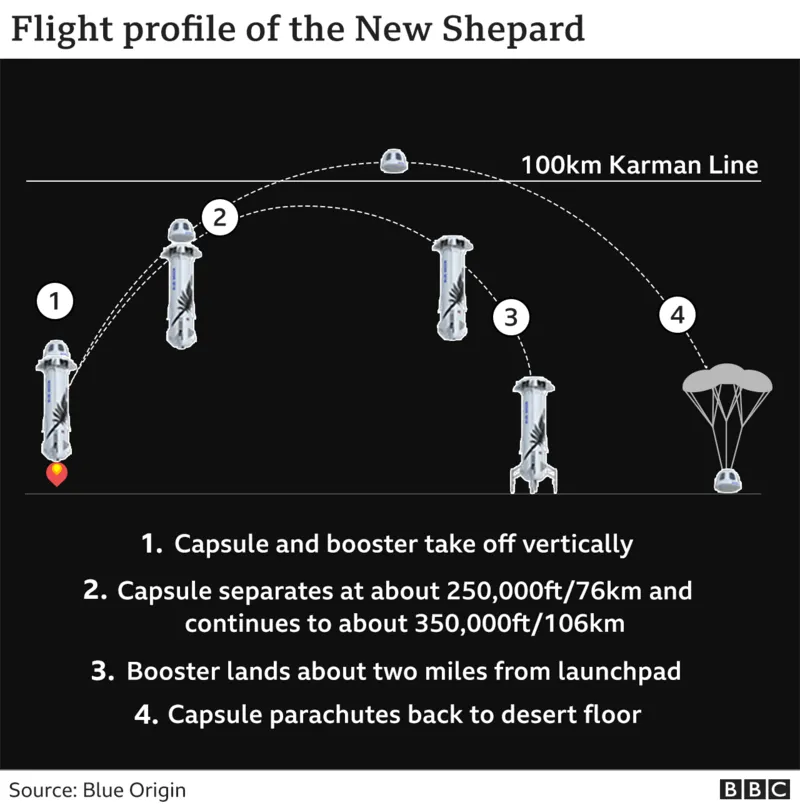BBC Climate & Science reporter
Science correspondent, BBC News
Pop star Katy Perry and five other women safely returned to Earth after reaching space aboard Jeff Bezos’ Blue Origin rocket.
The singer was joined by Bezos’s fiancée Lauren Sánchez and CBS presenter Gayle King, who said a highlight of the flight was hearing Perry sing Louis Armstrong’s “What a Wonderful World”.
After landing back on Earth, Perry said she felt “super connected to life” and “so connected to love”.
The flight lasted around 11 minutes and took the six women more than 100km (62 miles) above Earth, crossing the internationally recognised boundary of space and giving them a few moments of weightlessness.

Also on board were former Nasa rocket scientist Aisha Bowe, civil rights activist Amanda Nguyen, and film producer Kerianne Flynn.
The New Shepard rocket lifted off from its West Texas launch site just after 08:30 local time (14:30 BST).
The capsule returned to Earth with a parachute-assisted soft landing, while the rocket booster also landed back in Texas.
Cheering could be heard from inside the capsule as the recovery crew went to collect them.
Jeff Bezos opened the capsule door to welcome back Lauren Sánchez, the first to disembark.
“I’m so proud of this crew,” she said tearfully. “I can’t put it into words.”
She paused, before adding: “I looked out of the window and we got to see the moon.”
“Earth looked so quiet,” she said, adding that it was not what she expected. “It was quiet, but really alive.”
Next out was Katy Perry, who kissed the ground and lifted a daisy to the sky – her daughter is called Daisy.
 Dave Limp/Blue Origin
Dave Limp/Blue OriginGayle King also got on her knees and kissed the ground.
“I just want to have a moment with the ground, just appreciate the ground for just a second,” she said.
The last to get out, Kerianne Flynn, pointed at the sky and shouted: “I went to space.”
A celebrity cast had watched the launch from the ground.
Speaking from the viewing platform, Khloé Kardashian said: “I didn’t realise how emotional it would be, it’s hard to explain. I have all this adrenaline and I’m just standing here.”
“Whatever you dream of is in our reach, especially in today’s day and age. Dream big, wish for the stars—and one day, you could maybe be amongst them.” she added.
Oprah Winfrey spoke about her friend Gayle King, and revealed she was a nervous flier.
“I mean, for her—whew—anytime we’re on a flight, she’s in somebody’s lap at the slightest bit of turbulence. She has real, real-world anxiety when it comes to flying. And this… this is her overcoming a wall of fear,” she said.
The spacecraft was fully autonomous, requiring no pilots, and the crew did not manually operate the vehicle.
Blue Origin says the last all-female spaceflight was over 60 years ago when Soviet Cosmonaut Valentina Tereshkova became the first woman to travel into space on a solo mission aboard the spacecraft Vostok 6.
Since then, there have been no other all-female spaceflights but women have made numerous significant contributions.
The space tourism industry is still in its infancy, so every successful launch is significant and demonstrates that these short, commercial flights can be carried out safely.
 Getty Images
Getty ImagesBut some critics stress it is tourism, not space science, and professional astronauts undertake missions, including scientific research, for the benefit of humankind.
“A celebrity isn’t an envoy of humankind – they go into space for their own reasons,” Dr Kai-Uwe Schrogl, special advisor for political affairs at the European Space Agency, told BBC News.
“These flights are significant and exciting, but I think maybe they can also be a source of frustration for space scientists,” he added. “We see space flight as being for science, knowledge and the interests of humanity.
“Celebrities do it for amusement but get a lot more attention than the regular astronauts.”
In a news conference after the flight, two of the women took issue with some of the criticism the mission had received, related for example to its cost.
“I feel that anybody who is criticising doesn’t really understand what’s happening here,” said Gayle King.
She said that the astronauts had had a huge, positive response from young women and young girls.
Lauren Sánchez said she had got “fired up” about the criticism and would love to have the naysayers come to Blue Origin and see the thousands of employees who “put their heart and soul into” the missions.
Blue Origin is a private space company founded in 2000 by Bezos, the billionaire entrepreneur who also started Amazon.
Although Blue Origin has not released full ticket prices, a $150,000 (£114,575.85) deposit is required to reserve a seat—underlining the exclusivity of these early flights.
Alongside its suborbital tourism business, the company is also developing long-term space infrastructure, including reusable rockets and lunar landing systems.
The New Shepard rocket is designed to be fully reusable and its booster returns to the launch pad for vertical landings after each flight, reducing overall costs.
According to US law, astronauts must complete comprehensive training for their specific roles.
Blue Origin says its New Shepard passengers are trained over two days with a focus on physical fitness, emergency protocols, details about the safety measures and procedures for zero gravity.
Additionally, there are two support members referred to as Crew Member Seven: one provides continuous guidance to astronauts, while the other maintains communication from the control room during the mission.

The rise of space tourism has prompted criticism that it is too exclusive and environmentally damaging.
Supporters argue that private companies are accelerating innovation and making space more accessible.
Professor Brian Cox told the BBC in 2024: “Our civilisation needs to expand beyond our planet for so many reasons,” and believes that collaboration between NASA and commercial firms is a positive step.
Rocket engine exhaust contains gases and particles that can affect Earth’s climate and ozone layer.
On its web page under the title “Protecting our Planet” Blue Origin claims “During flight, the only byproduct of New Shepard’s engine combustion is water vapor with no carbon emissions.”
However, Eloise Marais, a professor of Atmospheric Chemistry and Air Quality at University College London points out that water vapour too is a greenhouse gas and is a chemical that is not supposed to be in the upper layers of the atmosphere.
“It alters the chemistry of the stratosphere, depleting the ozone layer, and also forms clouds that affect climate,” she says.
Experts say that as more and more rockets are launched, the risks of harming the ozone layer increases.
High-cost tourism
The high cost of space tourism makes it inaccessible to most people, with these expensive missions out of reach for the majority.
Critics, including actress Olivia Munn, questioned the optics of this particular venture, remarking “there’s a lot of people who can’t even afford eggs,” during an appearance on Today with Jenna & Friends.
Watch: Moment Blue Origin flight with all-female crew blasts off
Additonal reporting by Kate Stephens, BBC Climate and Science.




